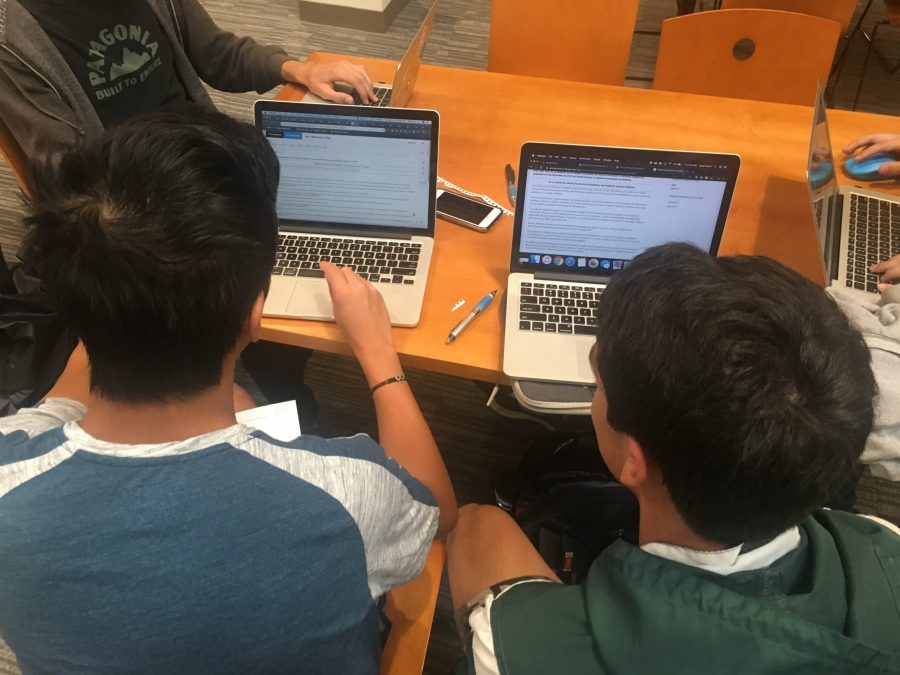In previous years, studying for AP tests was an antiquated experience: secure practice questions could not leave the classroom, and the only paperless aspect was the surrendering of study materials when the bell rang. This has all changed with the College Board introducing technology for high school AP classes nationwide. The AP Classroom online suite, launched August 1, contains modern tools that offer test creation and data analysis, and Paly teachers geared up to incorporate the software into their curriculums at the start of school.
AP teachers nationwide will have access to 15,000 practice questions designed to replicate those given on the AP exams to better prepare students for the exams. The collection was not readily available to students in previous years given the time restrictions involved with only being accessible during class time.
In addition, the online suite allows teachers to track class and individual student progress throughout the year, as well as highlight the strengths and weaknesses of each student on the covered material, according to the College Board website.
AP Spanish Language teacher Maria de Pilar said she is excited to use the new system.
“I have more flexibility to put the things that I want on each test,” Pilar said. “The tests I give in class are already done for me, which gives me less control. With AP Classroom, I can create and then assign tests where I have selected the questions and readings by hand.”
The new software doesn’t necessarily mean more material that staff will assign as homework for students, though. AP Environmental Science teacher Alicia Szebert said she has plans to use the program as a resource for students to reference outside of class when reviewing for the AP exam at the end of the school year, as opposed to assigning it as homework.
“Every unit, I’m planning to collect all of the old AP questions through AP Classroom, so that I can give them to students in the form of a practice test,” Szebert said. “It will be optional in APES, so it will still be on the students to use it, but it’s a really good resource to use if they choose. They can see the questions they got wrong, and for each one that is incorrect, an explanation why.”
Though staff say they are excited about the possibilities AP Classroom brings, the debut of the software has been anything but smooth. Many teachers said communication about issue resolution between the College Board and Paly staff was helpful and effective, but issues involving user account creation still proved difficult to resolve. Furthermore, on launch day, the software did not work for world language teachers.
“I had problems with the software where some students couldn’t get to a test, because I had given it a name that had some specific Spanish characters,” Pilar said.
In an ironic twist, AP Classroom software did not allow the creation of any spanish test with a tilde in the title, like the common spanish letter “Ñ”, according to Pilar. This bug resulted in a week-long delay before the issue was resolved.
Students have also experienced their own issues with the new software. Junior Gaurav Tyagi, who uses AP Classroom for his Chemistry class, said the software has glitched multiple times, including during a timed quiz.
“One of the technical difficulties I’ve had is when AP Classroom randomly logs me out,” Tyagi said. “It has crashed on me three times in the four hours I have spent online — once even in the middle of a quiz.”
Tyagi also said he worries that the website does a poor job of helping students study and learn.
“I say it’s not designed well for regular use, because navigating the site is so unintuitive,” Tyagi said. “I’ve had a hard time finding the scores for quizzes that I have already completed, which makes it hard to review.”
Szebert agrees and said the interface is not as user friendly as it could be.
“It is honestly better than I thought it would be, but there is a serious learning curve that you have to get used to,” Szebert said.
Though the departments plan to utilize AP Classroom differently, the common end goal is to have students getting practice before final AP exams in spring according to Pilar. With an online version of preparation resources available, the students will be encouraged to review material gradually through the year, as opposed to cramming study time into the two weeks leading up to the exams. Teachers see it as overall positive tool.
“AP Classroom is a great addition to the school program,” Pilar said. “The main thing for me is that my students use it to practice. I think it’s certainly the future of education.”

